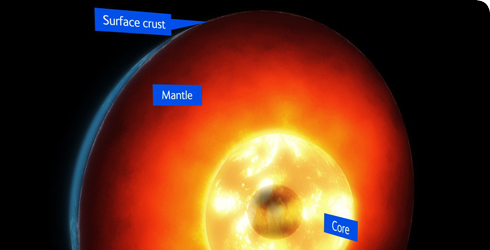Structure of the Earth
Earth has a layered structure, like an onion, with three main layers: the crust, mantle and core.
Crust
Varying between 5 and 70km thick, the outer layer of the Earth consists of two main types of crust – oceanic and continental. Oceanic crust is thinner than continental crust, but is composed of higher density rocks such as basalt.
Mantle
Below the crust the mantle extends to a depth of 3000km. The rocks down at this depth exist at temperatures of up to 3,500 ºC, but are not liquid, because of the immense pressures.
The top part of the mantle, together with the crust, forms the lithosphere, Earth's rigid outer shell. The lithosphere is split into huge tectonic plates that move a few centimetres every year. Further down0 is the aethenosphere, a less rigid part of the mantle on which the lithosphere floats.
Heat flowing from the core is thought to drive convection, circular movement of heat, within the mantle, which in turn is thought to cause the movement of the plates.
Find out what happens at plate boundaries
Samples of rock from the mantle, called mantle xenoliths, are brought to the surface by volcanic eruptions. This is how we know that the mantle is composed of silicate-based rocks rich in magnesium.
Core
Composed of iron and nickel, the core extends from below the mantle to the Earth’s centre, a depth of 6,400 km. The outer core is liquid, while the inner core is solid. Earth’s magnetic field is thought to originate in the core, caused by powerful currents in the outer core as charged particles are moved around by the heat from the inner core.
Rocks from the core never reach the surface, so the structure of the core is inferred from indirect observations of how seismic waves travel through the Earth. Meteorites, fragments of asteroids that have fallen to Earth, also provide clues because some meteorites come from the core of asteroids.
